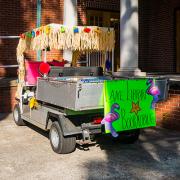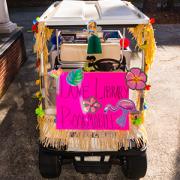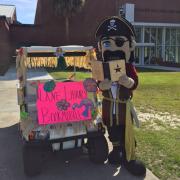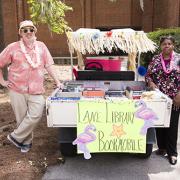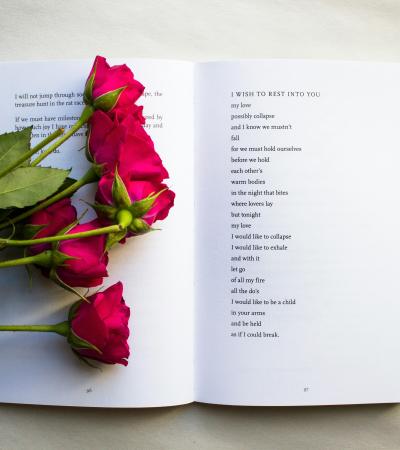For National Bookmobile Day 2017, my coworkers and I borrowed a cargo-bed golf cart from the university’s facilities department and converted it into a bookmobile. We decorated it with Hawaiian luau-themed party decorations and loaded the cargo bed with new books and DVDs.
We partnered with the university’s marketing department to announce the bookmobile’s campus route via Twitter. Over six hours, we made 12 stops on campus, rotating shifts with 11 library employees.
Advanced Planning
Our goal for the bookmobile program was to create good will with students around campus by bringing the library’s books to them, and also for the library to remain relevant. With all of the other noise on campus, it is increasingly hard to compete!
Since this was our first time doing this program, my two coworkers (David Messier and Vivian Bynoe) and I started planning one month in advance. In order to drive a university golf cart, we had to participate in a driver training course to get certified. Next, we planned our route around campus, which included 12 stops at various buildings over six hours.
We decided that for a day-long bookmobile adventure, we needed to recruit library volunteers to assist us with check-outs. We placed a sign-up sheet in the library’s break room and attracted 11 volunteers: library staff, faculty and work study students. We also placed a book recommendation form in the break room for people to write down must-have titles to put on the bookmobile. (View sample volunteer sign-up and book recommendation sheet sheets under Attachments at right.)
We decked out the bookmobile with Hawaiian luau-themed party decorations (e.g., grass skirt garland, paper flamingos, leis) that we purchased at a party store. We decided who would bring bug spray, sunscreen, a Bluetooth speaker to play Hawaiian music, and snacks on the day of the event. We made colorful bookmobile posters to affix to the golf cart and prepared hand-stamped due date cards to put in the materials that got checked out during the program.
Marketing
We began marketing the event to our students about three weeks before the date. I used the website Canva to create a National Library Week poster that I displayed at service desks in the library; I also made a social media poster that I posted on the library’s Facebook page and blog. In hindsight, I should have made bookmobile-specific posters to hang around campus to generate more interest and create more anticipation.
I contacted the university photographer to take pictures of students interacting with the bookmobile so that the pictures could be published on the university’s various social media platforms. I also asked the university’s PR coordinator to tweet the bookmobile’s route in real-time. I emailed each of them the route once it was developed.
Budgeting
I spent under $50 on the Hawaiian-themed party decorations, which I purchased from Party City. We were able to carefully remove them from the bookmobile after the program so they could be reused. Next time we do this program it won’t cost any money!
Day-of-event Activity
The day of the event was fast-paced. My coworker picked up the golf cart from the facilities department at 7:30 a.m. At 8 a.m., three people began decorating it so it would be ready to roll out of our loading dock at 9:40. One of my coworkers is a professional photographer, so he had just enough time to photograph it before we pulled out!
While this was happening, I pulled the library employee’s recommended titles from the stacks, as well as many of the library’s newer titles and DVDs. I ended up pulling way too many books and DVDs; in my excitement, I pulled approximately 200 items; only 15 were checked out.
Driving the pre-planned route and dropping off/picking up volunteers as needed worked out very well. Along the way, we received quizzical looks from many students wondering what our funny contraption was. Many were astonished they could check out books from us, and many were surprised that the campus even had a library! Most students and university employees we encountered, though, thanked us for providing this fun service.
We intended to record barcodes and patron names on an offline circulation form for items we checked out, but it proved easier to take a picture using our phones of the student’s ID (with his/her name visible) alongside the material’s barcode. We then texted these pictures to one of the library’s circulation assistants to manually enter into the library’s ILS.
Program Execution
As a result of extensive planning, the bookmobile program was well-executed. I was initially disappointed that only 15 items were checked out, but I changed my perspective after my coworkers explained to me that we reached countless students, and thus achieved program success. I agreed with them that we achieved our goal!
It’s impossible to quantifiably evaluate this program. It’s not exactly ideal to have one hand on the wheel of the golf cart while using the other to tally the students you encounter with a clicker! Circulation statistics are not appropriate for evaluating this program either, as I discovered.
It’s much easier to qualitatively evaluate this program. Did the bookmobile make people smile? Did it make them stop and talk to you? Did it provide hours of enjoyment for all who came in contact with it? If you can answer yes to these questions, then you conducted a program worth repeating!
Advice
Have fun with this program, but do your homework! It requires a lot of preparation the first time you execute it. Don’t bring too many materials. Keep in mind that some poor student worker has to re-shelve everything that doesn’t get checked out.
My coworkers and I repeated this program at the campus farmers’ market this past April. This time, we only brought about 60 books/DVDs, we parked under a tent, and we played 1980s music on a Bluetooth speaker. We still decked out the bookmobile with the Hawaiian decorations, but didn’t use quite all of them. We kept it simpler, which really reduced stress levels.


